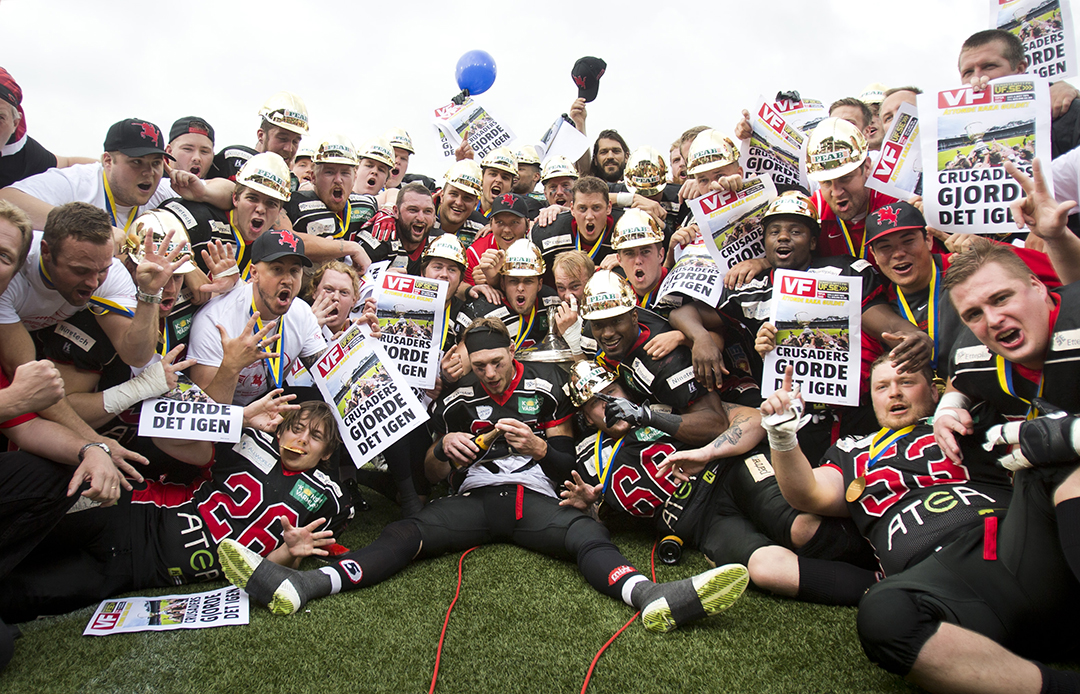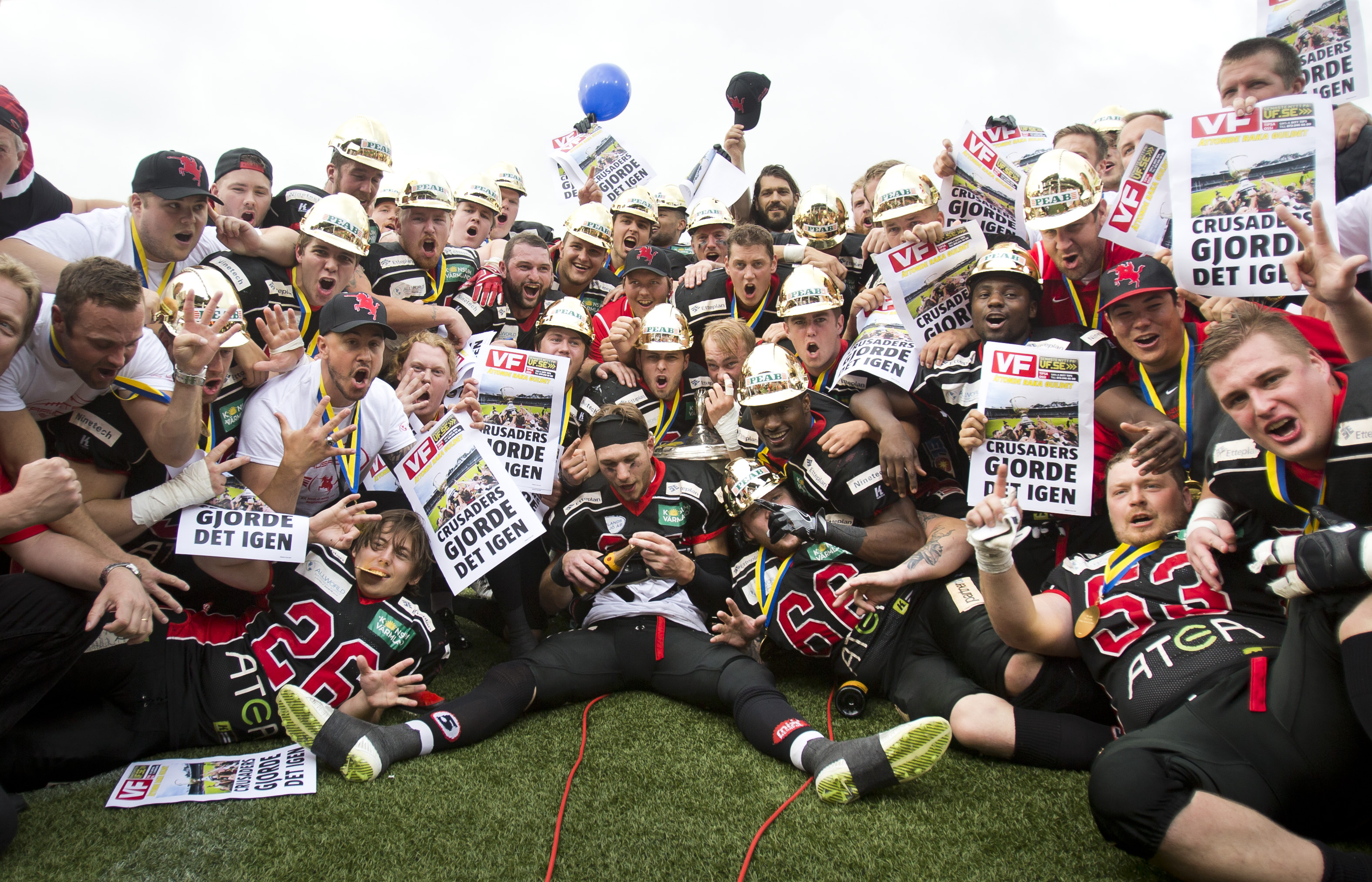Carlstad launches crusade for American football
We want to create connections for players coming to Sweden after they graduate from American universities and for Swedish players going to universities in the U.S.
-
 The Carlstad Crusaders celebrate winning the Swedish championship July 8 after defeating Orebro in the final of the Swedish American Football League. Bildbyrån photo/Johan Bernström
The Carlstad Crusaders celebrate winning the Swedish championship July 8 after defeating Orebro in the final of the Swedish American Football League. Bildbyrån photo/Johan Bernström -
-
The mythical Joe Jackson of “Field of Dreams” isn’t the only one who believes “if you build it, they will come.” The Carlstad Crusaders are out to prove just how true those words can be.
The top American football team in Northern Europe and two-time European champion Carlstad, of Karlstad, Sweden, now has its sights set on building a state-of-the-art training facility. The facility will make the club the focal point of the sport’s development in the Nordic region and open the door for players around Europe to play for top collegiate programs in the United States. -
 The Carlstad Crusaders celebrate winning the Swedish championship July 8 after defeating Orebro in the final of the Swedish American Football League. Bidlbyran photo/Johan Bernström
The Carlstad Crusaders celebrate winning the Swedish championship July 8 after defeating Orebro in the final of the Swedish American Football League. Bidlbyran photo/Johan Bernström -
-
Crusaders General Manager Robert Sundberg was in the United States October 23-30 as he made the rounds in the heart of Swedish America to raise the final funding the club needs to complete its project.
The Crusaders’ potential new home would feature a lighted, all-season artificial turf practice facility, clubhouse, classrooms, offices, meeting spaces and training facilities. The projected cost is $3 million, of which Sundberg said he has secured roughly two-thirds in the form of grants and sponsorships. The grants, however, come with at least one caveat:
“We have to raise private funds to match the grants.” Sundberg came to Illinois, Michigan and Minnesota to meet with groups and individuals “who think it is important for the sport to grow and to give kids the chance to experience American football.”
The new facility would be home to the nearly dozen youth teams Carlstad currently runs and would serve as the practice facility for the Crusaders A team. They currently rent space at various indoor facilities to conduct short field drills, but a year-round facility would allow its players to take the next steps needed to advance.
“Right now, we don’t even have locker rooms,” Sundberg said. “The players have to change at home and come to practice dressed, then go back home again to get cleaned up. We don’t have any lights, so in the winter when it is dark for longer periods we only have a very short period when we can train.” -
Creating opportunities
Sundberg met with Swedish American Chambers of Commerce as well as officials from the Green Bay Packers, North Park University in Illinois and the University of Minnesota. He said those meetings were more about opportunities than fundraising.
“We want to spread the word about our club and what we are trying to do,” Sundberg said. “We want to create connections for players coming to Sweden after they graduate from American universities and for Swedish players going to universities in the U.S.”
American football is among the fastest growing sports in Sweden. Carlstad currently has teams for youth ranging in ages from 11 to 19 as well as the Crusaders A team. Much of the reason for the growth, Sundberg said, is the accessibility of the NFL.
“It is hip to follow the NFL in Sweden,” Sundberg said. “The internet and TV contracts have made it easy. There are games live on TV in Sweden now and the internet makes it very easy to follow. The interest is exploding.”
The Crusaders are eager to capitalize on the interest, not only to grow their own brand but to help the sport grow. Sundberg said the club emphasizes its core values when it welcomes new players, coaches and supporters. “We want the club to be a second family,” he said. “It doesn’t matter if you are big or little, fast or slow, where are you from — everyone is welcome here.” -
Still developing
Although it is growing in popularity, American football in Sweden continues to face development hurdles. Liberty University’s Alpha Jalloh, who played for the Crusaders last season, said Swedish players often lack a step or two when compared to those in England and Germany. “It is definitely a little bit slower, but the level is still good,” Jalloh said.
Part of the reason lies in the rules under which Swedish football operates. Clubs such as Carlstad can only have two “import” players (Americans) on their roster, although they can have up to six European (non-Swedish) players. Sundberg said while every team has the two American players, most are unable to attract the six non-Swedish players, probably because of the facilities.
The proposed facility would allow them to implement a year-round training program that would not only help develop skills but it would also serve as an enticement to non-Swedes to come to Sweden to further their careers.
A crowdfunding page has been established a to allow the Crusaders to take donations from the global American football community, and Sundberg said there is special recognition for anyone donating more than $1,000 to the project: www.indiegogo.com/projects/carlstad-crusaders-sport-center#
The project exemplifies not just the growth but the ambition of American football in Sweden. “It is a huge project for us,” Sundberg said. “We want this to be the go-to place when you talk about American football in northern Europe or have the NFL look at Nordic players or have [tryout] camps at our facilities, we want this to be the place for the sport.”
Chipp Reid -
-
